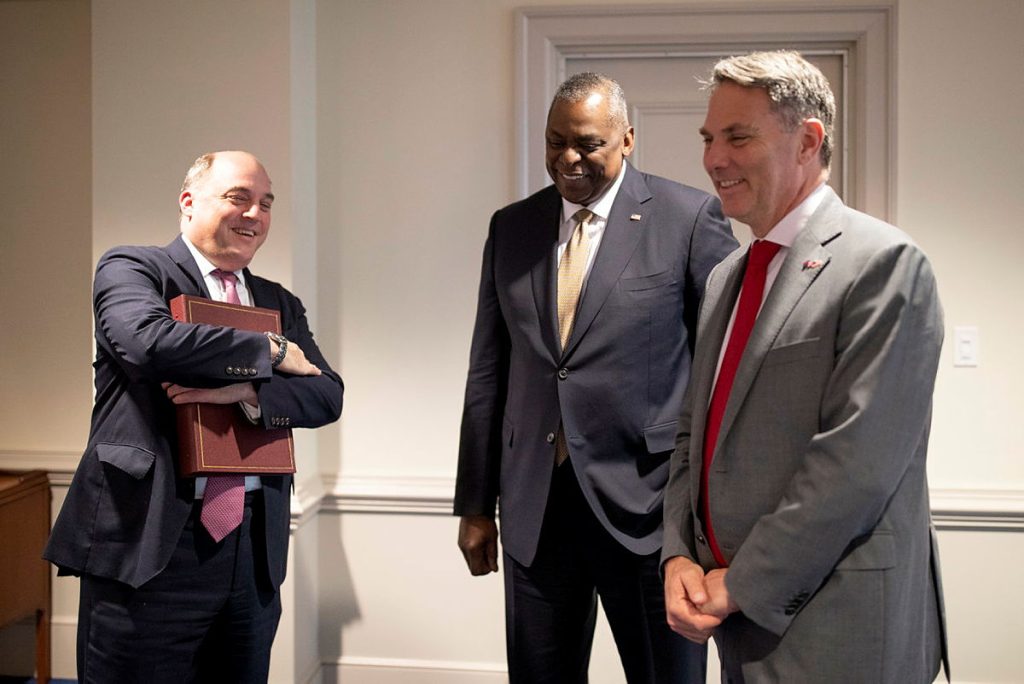
From its inception, the AUKUS pact has been wrapped in expectations. Fundamentally, it is a technology and capability agreement—an accelerator.
That may sound mundane but it is incredibly challenging. To realise its promise, three sovereign nations, Australia, the UK and the US, need to align their capability development, collaborative research and respective defence industrial bases.
Let’s leave the submarines to one side—this article concerns pillar two of AUKUS, the technology programs, which are arguably of greater potential value over the long-term.
In the past, a defence technology agreement would be allowed to progress at a measured pace, with committees and considered research proposals in the respective defence science organisations.
But tightening geopolitical circumstances demand urgency: AUKUS needs to deliver. Politicians won’t be able to wait for favourable winds but need to begin today to do the heavy lifting of organisational change, budget prioritisation and making the case to sceptical electorates.
Australia is the smallest partner, the most exposed geopolitically, and the most in need of a technological uplift. It has the most to gain from AUKUS but only if it is prepared to make the greatest effort. Sustained Australian political investment in the program has to be matched by directed, ongoing financial support and structural change.
Funding has one of two sources: supplementation through the federal budget process or from within Defence’s existing budget. Both, of course, mean the taxpayer pays.
Prospects of supplementation from the budget are slim. Though the Labor government has endorsed AUKUS, and concerns are growing over the strategic environment, defence warranted only passing mention in the October 2022 budget. Defence is not where government wants to spend any spare cash.
Not that there’s much to be had. The federal budget is under significant pressure—measured against expectations, it always is. But worsening economic conditions—inflation, rising interest rates and a slowing Chinese economy—are adding pressure just as public sector demand is increasing.
Further, government debt, mostly assumed during the Covid-19 pandemic and at its highest level since World War II, was locked in with comparatively low interest rates (though interest payments are projected to rise significantly).
That’s the good news. Now that rates are rising with the need to control inflation, any further debt will be more costly. And while current levels of debt are manageable, prudence suggests paying it down quickly to allow manoeuvring room for the unexpected in a volatile environment.
Given that, it’s of little surprise that Treasurer Jim Chalmers is looking to the private sector to ‘co-invest’. But let’s be clear: while industry has a role, we should not kid ourselves that industry will pony up to meet shortfalls in defence funding. Companies aren’t charities.
In short, any new initiatives, or shifts in priorities, to fund AUKUS projects—including the submarines—will need to come from within existing Defence funding.
That’s going to be tough. The defence strategic review is likely to try to prod Defence into shifting some priorities. But the way Defence is funded—managed largely by itself within an agreed envelope—though tactically convenient, can make it hard to turn the ship of strategy. The internal momentum of existing programs and invested constituencies often outweighs any prospect for change.
New capabilities, like missiles, are welcomed—provided they do not upset the existing order. Politicians are wary of being labelled anti-Defence and so are reluctant to force choices, regardless of need. Consequently, the capability equation within Defence is one of replacement and summation, not transformation.
The final concern about AUKUS funding is the role of the Defence budget in the broader budgeting effort. Simply put, the Defence budget functions as a balancing factor.
Defence is the last portfolio considered in the round of expenditure committees that shape the budget. By then the government knows how much it may need Defence to forego from its envelope over the forward years to offset other budget priorities.
When slicing happens, the programs most at risk are those without an internal service constituency, such as pillar two of AUKUS.
What can be done to help realise the promise of AUKUS?
First, independent funding. A fund for AUKUS pillar two needs to be carved out of the Defence budget and administered separately.
Consider it a future fund for Defence—but one concerned with the here and now, drawing on the breadth of government, not simply the Defence portfolio. After all, the AUKUS technologies involved are not the sole preserve of the military but are inherently civilian.
Second, explicitly embrace dual timelines—short- and medium-term.
In the short-term, focus on what can be done now, with existing capabilities and technologies, for deployment in three to 12 months.
Recombination is common in the commercial sector. It is fundamentally an engineering and product, or capability, manager effort. In business, it can be found in fablabs and hackathons and the continual experimentation of lean start-ups.
The medium-term needs to consider translation of current applied research into capability deployable in the 12-to-36-month window, supported by a broader ecosystem.
Last, create new governance arrangements.
There are two parts to AUKUS pillar two: broad exploration and rapid translation. Neither are suited to the existing frameworks and culture of Defence—or the Australian Public Service, for that matter. Keeping pillar two behind the high walls of Defence will drive up costs and starve any prospective innovation system.
A new approach is needed, especially if AUKUS is to be part of a nation-building effort, to help enforce an AUKUS-by-design ethos, and avoid unwarranted taxpayer subsidisation of industry. In an economy built around extractive industries, that task should not be under-estimated.
At a time when the government is seized with social and economic change and debt is already high, the cost of realising AUKUS will be taken from within Defence. We’ve yet to see whether ministers have the stomach for the shaping and sustained effort needed to realise the pact’s potential.
AUTHOR
Lesley Seebeck is an independent consultant and an honorary professor at the Australian National University. Image: Department of Defence.


